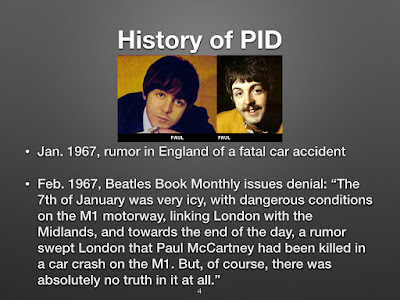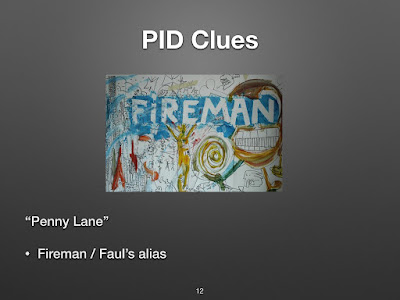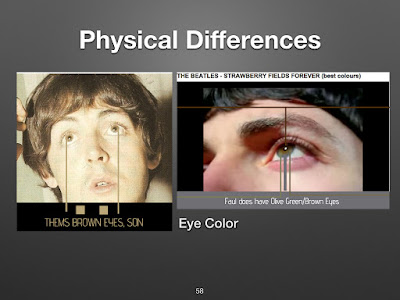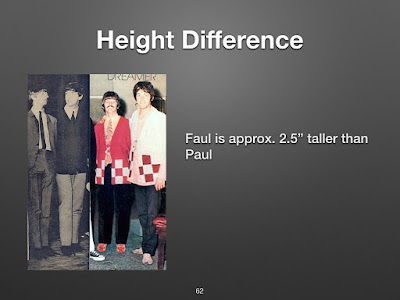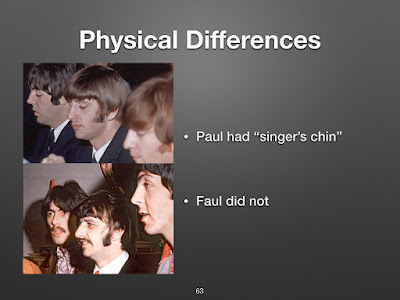Five Reasons to Believe “Paul is Dead”
by Brody Duggerson
Paul McCartney (left) Aug. 19, 1966 vs. Faul (right) Dec. 1966
It’s the “Second Gunman Theory” of rock and roll. I’m of course talking about “Paul is Dead.”
Leave it to the greatest rock band of all-time to be associated with rock’s greatest conspiracy.
“Paul is Dead” is a theory that says Paul McCartney died in car crash in late 1966 and was replaced by a look-a-like. He was replaced, it’s assumed, to keep the Beatles’ commercial interests afloat and/or appease powerful political forces.
Obviously, this was before the realization that “death” is about the best thing that can happen to a career.
The theory started from a “rumor” that McCartney was involved in a fatal car accident—“He blew his mind out in a car.” The theory was supported by clues found within Beatles songs and within their album covers.
For example:
- John Lennon reportedly sang “I buried Paul” at the end of “Strawberry Fields Forever.”
- A funeral procession is supposedly depicted on the cover of Abbey Road. The Fab Four symbolize, from right to left, a heavenly figure (John), an undertaker (Ringo Starr), a corpse (barefooted Paul) and a gravedigger (George Harrison).
To learn more about “PID” (Paul is dead) check out the thorough and straightforward Paul is Dead presentation. It’s a fascinating and sobering read.
Beatles followers, rock fans, and conspiracy doubters may scoff at PID and claim its nothing more than an urban legend, a rumor run amuck, or a complicated marketing ploy (there’s evidence that it increased Beatles’ album sales). Before you do, consider the following...
It’s not difficult to replace a dead person. Paul’s identity was already established and if people can see him and hear him sing, why would they assume he’s dead? The only person you really had to worry about raising suspicion was the person replacing him. If that person had no family, no one to ask about his whereabouts, you had a chance of pulling off the ruse. It still would have been extremely difficult, but possible. Remember, Paul’s mother died when he was 14. This meant the person most likely to discover the switch was out of the picture.
Don’t underestimate the Beatles earning potential. The Beatles were a license to print money, even after they stopped touring. The tremendous amount of wealth the band generated was more than enough to inspire the coverup, pay for the coverup, and ensure that the other three Beatles kept quiet.
Political powerbrokers didn’t want a martyr. A live subservient Paul McCartney was much better than a dead subversive one. That’s exactly what would have happened had the public known that Macca died in a car crash in 1966. While other icons of the 1960s lost their potency in death, a dead Beatle would have certainly become more powerful. Remember, Richard Nixon was so scared of what John Lennon might do to his reelection campaign that he had the FBI follow him. The powers-that-be in the 1960s were petrified over the influence The Beatles had over the world’s youth.
PID occurred during mass media’s infancy. In the second half of the 1960s, cutting edge technology was stereo sound and color television. Social media, much less the internet, wasn’t even on the radar. Sure, Paul was one of the decades’ most famous personages, and well photographed, but it pales in comparison to the amount of media attention received by today’s celebrities. In the mid-1960s, there just wasn’t enough visual data to spoil the subterfuge.
Leaving clues behind is completely logical. If powerful people are tricking the world with a Paul imposter then why are clues of the conspiracy found in the Beatles’ media? Why mention it at all? Simple, some of the individuals in on the conspiracy knew they’d have to take the secret to their graves. Nonetheless, they wanted the truth to be known. Since they couldn’t tell the world directly, they decided to tell the world indirectly through carefully crafted clues. This practice has been used throughout history especially during eras when information and free thought was greatly oppressed.
Email Tina at faulconandsnowjob at hotmail dot com.
______________________________________
Tina Foster is the author of
Email Tina at faulconandsnowjob at hotmail dot com.






